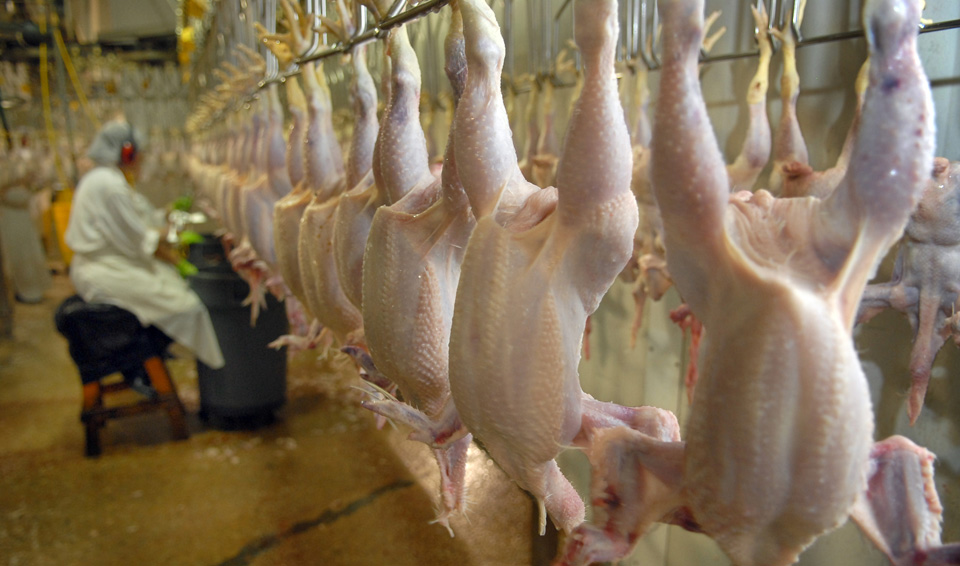
WASHINGTON—More sick chickens on consumers’ plates? More injured poultry plant workers? Those alarming prospects led a coalition of unions, consumer groups, food safety groups, workers’ rights groups, and the NAACP to protest a Georgia Republican congressman’s demand to speed up production lines at chicken processing plants.
Speeding up the lines to three chickens a second, they told Trump administration Agriculture Secretary Sonny Perdue, also a Georgia Republican, but not part of the Perdue Farms chicken company, could injure more workers and make more consumers sick.
Indeed, conditions are so bad in poultry plants already that many workers, denied bathroom breaks, wind up soiling themselves while on the job, increasing the risk of disease not just to themselves, but to consumers, the groups warn. And the workers get injured, often.
“Increasing the line speed by a full 25 percent to a shocking 175 birds per minute—or 3 birds per second—would only make a bad situation worse,” the groups, including the Teamsters, the United Food and Commercial Workers, and the Knoxville-Oak Ridge, Tenn., Central Labor Council, warn. UFCW represents thousands of the nation’s 250,000 chicken processing workers.
“This is evident for anyone who has visited a poultry plant. Workers stand, shoulder to shoulder, in cramped quarters, amid deafening noise and slippery conditions. They make thousands of forceful cuts a day at break-neck speed, using sharp knives and scissors, with acidic chemicals sprayed over the meat, and onto the skin, and into the eyes, nose, and throat of the workers, as the meat moves down the line.
“A single wrong move could lead to an amputated finger or life-threatening cut. And cumulatively, these repetitive movements cause irreparable damage to the nerves, tendons, and muscles of the workers.” The chicken plant lines now move at up to 140 birds per minute.
Consumers are at risk, too, the letter from the unions and their allies warns, as the possibility for food contamination increases.
The speedup demand by Rep. Doug Collins, R-Ga., whose northeastern district is one of the nation’s largest chicken-production/processing areas, is the second time in the last few years USDA came under industry and congressional pressure to speed up chicken lines.
Last time, the Democratic Obama administration’s plan forced the agency’s safety inspectors, represented by the Government Employees (AFGE), into a picket line in front of USDA headquarters in D.C. It didn’t work, as USDA approved an industry proposal to speed up the lines to 140 birds per minute. Now, Collins wants the faster line speeds.
Even the 140-birds pace, the AFGEers said then, would reduce food safety by allowing more sick chickens to get through eyeball inspections, while forcing workers to struggle to keep up, increasing the risk of injury on the job, especially ergonomic (repetitive-motion) injury.
Collins, whose website openly boasts he “hopes to be a voice for agribusiness and agritourism for the 9th District to make sure neither are constrained by big government or erroneous regulations from unelected, unaccountable bureaucrats,” wants to increase those line speeds. He says the chicken processors need faster speeds to keep up with German and Belgian competitors’ speeds of 200 birds a minute.
Left unsaid: The point AFGE demonstrators made the last time—that increased line speeds not only harmed workers and consumers, but increased chicken company profits.
The objecting groups call Collins’ push to increase chicken line speeds not just ridiculous, but dangerous to the workers. Though they did not say so, most chicken processing plant workers are exploited minority-group members and/or women and/or immigrants.
Besides the unions, other objectors to Collins’ chicken line speedup include Interfaith Worker Justice, the National Employment Law Project, the Southern Poverty Law Center, the NAACP, the National Council of LaRaza (now renamed Unidos), the National Council on Occupational Safety and Health, the Presbyterian Church’s social action arm, and the Western North Carolina Workers Center.
“Even at current speeds, poultry slaughter and processing workers face serious job hazards that result in debilitating illness, injury, or death,” their heavily footnoted letter says. “Indeed, workers in poultry plants are injured at almost twice the rate of workers in private industry. Workers face over seven times the national average of occupational illnesses, such as repetitive motion injuries. And, as USDA noted, these rates are likely underreported.
“Despite Collins’ claim production line speed is unrelated to worker health, experts are convinced otherwise… [L]ine speed” plus forceful exertions, awkward postures, and the cold temperature of chicken processing plants, raises the “risk of both musculoskeletal disorders and injuries among workers,” they said. One study sent to the feds showed one-third of chicken plant workers suffered carpal tunnel syndrome and three-fourths had nerve damage to their wrists and hands. Another study found as many as 42 percent of workers suffered carpal tunnel.
“These numbers are not an unhappy coincidence…the faster the line speed, the greater the risk of harm.”
The groups also dismissed Collins’ claim U.S. chicken processors need faster line speeds to keep up with the Germans and the Belgians. German and Belgian chickens aren’t allowed into the U.S., they note, due to questions about health hazards—including higher rates of salmonella and camplyobactyr contamination—that occur due to higher chicken line speeds.










